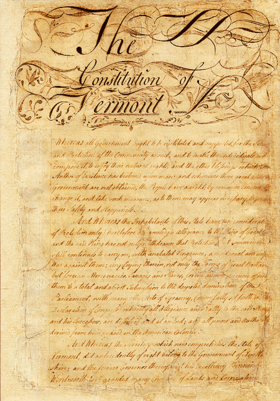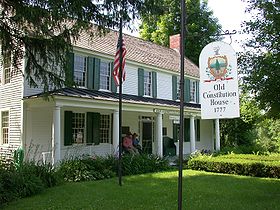
Constitution of the Vermont Republic
Encyclopedia


Constitution
A constitution is a set of fundamental principles or established precedents according to which a state or other organization is governed. These rules together make up, i.e. constitute, what the entity is...
when it existed as the independent Vermont Republic
Vermont Republic
The term Vermont Republic has been used by later historians for the government of what became modern Vermont from 1777 to 1791. In July 1777 delegates from 28 towns met and declared independence from jurisdictions and land claims of British colonies in New Hampshire and New York. They also...
or, more correctly, the Commonwealth of Vermont, from 1777 to 1791. The official title of the document was simply the Constitution of Vermont. The constitution was adopted in 1777 when Vermont
Vermont
Vermont is a state in the New England region of the northeastern United States of America. The state ranks 43rd in land area, , and 45th in total area. Its population according to the 2010 census, 630,337, is the second smallest in the country, larger only than Wyoming. It is the only New England...
declared independence from the British Empire
British Empire
The British Empire comprised the dominions, colonies, protectorates, mandates and other territories ruled or administered by the United Kingdom. It originated with the overseas colonies and trading posts established by England in the late 16th and early 17th centuries. At its height, it was the...
. In 1791 Vermont became the fourteenth U.S. state
U.S. state
A U.S. state is any one of the 50 federated states of the United States of America that share sovereignty with the federal government. Because of this shared sovereignty, an American is a citizen both of the federal entity and of his or her state of domicile. Four states use the official title of...
and in 1793 it adopted its current constitution, the Constitution of the State of Vermont
Constitution of Vermont
The Constitution of the State of Vermont is the fundamental body of law of the U.S. State of Vermont. It was adopted in 1793 following Vermont's admission to the Union in 1791 and is largely based upon the 1777 Constitution of Vermont which was ratified at Windsor in the Old Constitution House. At...
. The 1777 constitution was the first in what is now the territory of the United States to prohibit slavery
Slavery
Slavery is a system under which people are treated as property to be bought and sold, and are forced to work. Slaves can be held against their will from the time of their capture, purchase or birth, and deprived of the right to leave, to refuse to work, or to demand compensation...
, grant suffrage
Suffrage
Suffrage, political franchise, or simply the franchise, distinct from mere voting rights, is the civil right to vote gained through the democratic process...
s to non-landowning males, and require free public education
Public education
State schools, also known in the United States and Canada as public schools,In much of the Commonwealth, including Australia, New Zealand, South Africa, and the United Kingdom, the terms 'public education', 'public school' and 'independent school' are used for private schools, that is, schools...
.
The constitution was adopted on July 8, 1777, at the tavern
Tavern
A tavern is a place of business where people gather to drink alcoholic beverages and be served food, and in some cases, where travelers receive lodging....
in Windsor
Windsor, Vermont
Windsor is a town in Windsor County, Vermont, United States. The population was 3,756 at the 2000 census.-History:One of the New Hampshire grants, Windsor was chartered as a town on July 6, 1761 by Colonial Governor Benning Wentworth. It was first settled in August 1764 by Captain Steele Smith and...
now known as the Old Constitution House
Old Constitution House
The Old Constitution House located at Windsor in the U.S. state of Vermont is the birthplace of the Vermont Republic and the Constitution of the State of Vermont. A mid-18 century building built in a simple Georgian architectural style, the Old Constitution House was originally called the Windsor...
and administered as a state historic site. The constitution consisted of three main parts. The first was a preamble
Preamble
A preamble is an introductory and expressionary statement in a document that explains the document's purpose and underlying philosophy. When applied to the opening paragraphs of a statute, it may recite historical facts pertinent to the subject of the statute...
reminiscent of the United States Declaration of Independence
United States Declaration of Independence
The Declaration of Independence was a statement adopted by the Continental Congress on July 4, 1776, which announced that the thirteen American colonies then at war with Great Britain regarded themselves as independent states, and no longer a part of the British Empire. John Adams put forth a...
:
- It is absolutely necessary, for the welfare and safety of the inhabitants of this State, that it should be, henceforth, a free and independent State; and that a just, permanent, and proper form of government, should exist in it, derived from, and founded on, the authority of the people only, agreeable to the direction of the honorable American Congress.
(Here the term "American Congress" refers to the Continental Congress
Continental Congress
The Continental Congress was a convention of delegates called together from the Thirteen Colonies that became the governing body of the United States during the American Revolution....
, not the United States Congress
United States Congress
The United States Congress is the bicameral legislature of the federal government of the United States, consisting of the Senate and the House of Representatives. The Congress meets in the United States Capitol in Washington, D.C....
, which had not yet been established.)
The second part of the 1777 constitution was Chapter 1, a "Declaration of the Rights of the Inhabitants of the State of Vermont." This chapter was composed of 19 articles guaranteeing various civil and political rights in Vermont:
- The first article declared that "all men are born equally free and independent, and have certain natural, inherent and unalienable rights, amongst which are the enjoying and defending life and liberty; acquiring, possessing and protecting property, and pursuing and obtaining happiness and safety," echoing the famous phrases in the Declaration of Independence that declared that "all men are created equalAll men are created equalThe quotation "All men are created equal" has been called an "immortal declaration", and "perhaps" the single phrase of the United States Revolutionary period with the greatest "continuing importance". Thomas Jefferson first used the phrase in the Declaration of Independence as a rebuttal to the...
" and possess "inalienable rights," including "life, liberty and the pursuit of happinessLife, liberty and the pursuit of happiness"Life, Liberty and the pursuit of Happiness" is a well-known phrase in the United States Declaration of Independence and considered by some as part of one of the most well crafted, influential sentences in the history of the English language...
." The article went on to declare that because of these principles, "no male person, born in this country, or brought from over sea, ought to be holden by law, to serve any person, as a servant, slave or apprentice, after he arrives to the age of twenty-one Years, nor female, in like manner, after she arrives to the age of eighteen years, unless they are bound by their own consent." This effectively outlawed slavery and indentured servitude in Vermont. - The second article declared that "private propertyPrivate propertyPrivate property is the right of persons and firms to obtain, own, control, employ, dispose of, and bequeath land, capital, and other forms of property. Private property is distinguishable from public property, which refers to assets owned by a state, community or government rather than by...
ought to be subservient to public usesPublic propertyPublic property is property, which is dedicated to the use of the public. It is a subset of state property. The term may be used either to describe the use to which the property is put, or to describe the character of its ownership...
, when necessity requires it; nevertheless, whenever any particular man's property is taken for the use of the public, the owner ought to receive an equivalent in money." This established the basic principles of eminent domainEminent domainEminent domain , compulsory purchase , resumption/compulsory acquisition , or expropriation is an action of the state to seize a citizen's private property, expropriate property, or seize a citizen's rights in property with due monetary compensation, but without the owner's consent...
in Vermont.
External links
- http://vermont-archives.org/govhistory/constitut/con77.htm The Vermont State Archives text of the Vermont RepublicVermont RepublicThe term Vermont Republic has been used by later historians for the government of what became modern Vermont from 1777 to 1791. In July 1777 delegates from 28 towns met and declared independence from jurisdictions and land claims of British colonies in New Hampshire and New York. They also...
constitution - http://vermont-archives.org/govhistory/constitut/con86.htm The Vermont State Archives text of the 1786 constitution
- http://vermont-archives.org/govhistory/constitut/con93.htm The Vermont State Archives text of the 1793 constitution
- http://www.dhca.state.vt.us/HistoricSites/html/constitution.html Visit the birthplace of Vermont and its constitution
- http://www.thearchivalimage.com/detail.php?printNo=111 See the original constitution manuscript

